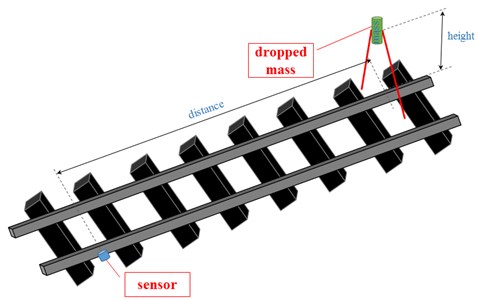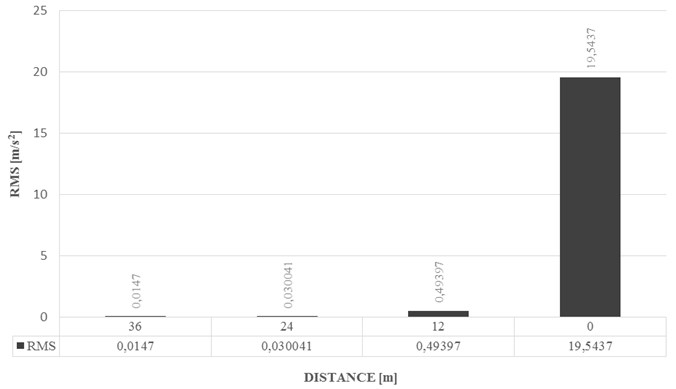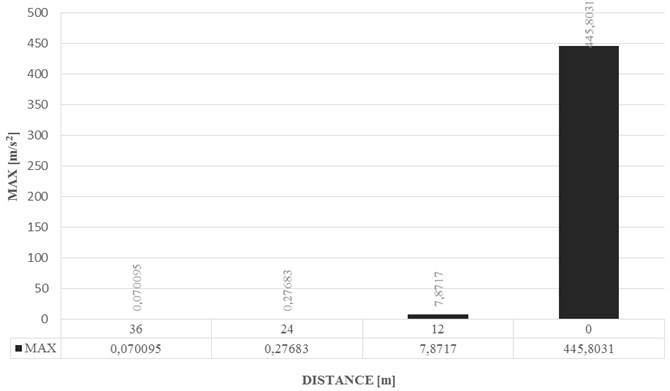Abstract
The paper presents extended abstract on preliminary research on influence of impulse force on vertical vibration of the rail. Research method was the impulse method for measuring the vibration response at specific points of track. It presents the waveforms of the vibration for the different distance from sensor to impulse point and distribution of the maximum and RMS values.
1. Introduction
Research on train or rail vibration is scope of investigation all around the world since many years, but it is still an interesting and relatively unexplored field of science. Especially nowadays, when high speed trains become more popular. For high speed trains, the forces induced by the track unevenness, although filtered by the primary and secondary suspension systems, can lead to a significant excitation not only of the carbody motion as a rigid body, but also of its flexible vibration modes [1]. Vibrations from trains propagating from the rail to the ballast go through the sleepers and strainings these elements [2]. Propagation of the vibration is very important phenomenon in every machine and technical or engineering objects. For the safety and comfort of means of transport it is very important what kind of vibration are transferred from rolling wheels and others vibration sources of the vehicle to the human body. For a railway system, the excitation on the ground’s surface is generated mainly by irregular contact between the wheel and the rail due to manufacturing defects or wear and tear [3].
There are two basic types of structural vibration: steady-state vibration caused by continually running machines such as engines, and transient vibration caused by a short-duration disturbance such as train passing over an expansion joint in a rail. The major source of railway rolling vibration is the structural vibration of the wheel and rail which is generated by the combination of small-scale undulations on the wheel and rail contact surfaces.
The authors have conducted some preliminary research on application of vibration signals for analysis of driving properties of rail vehicles. The papers [5, 6] present the research on possibilities of applicability of vibration signals of train driver's cab for train control and concept of vibration based support safety system. The paper [7] presents results of proposed metric calculated as inverse tangent function of current longitudinal and transverse accelerations. The paper [8] presents rail vibration signals registered as results of regular functionality of railway infrastructure.
2. Research and results
The main propagation path in railway transport is the track. Authors decided to conduct investigation on the propagation of vibration in the track. Thus, as the basic research method was chosen the impulse method for measuring the vibration response at specific points of track. Impulse response studies use a drop method that uses a free fall phenomenon to ensure repeatability of weight and heights, and guarantees uniform force throughout the study (Fig. 1).
The experiment was conducted on the experimental real size track. The track used was composed of two rails lying on wood sleepers joined by railpads. During the research, the vertical acceleration of vibration was recorded. The measuring system allowed synchronous recording signals that determined the correct analysis with respect to the time domain. The waveforms of the vibration for the different distance from sensor to impulse point have been depicted in Fig. 2.
Fig. 1Scheme of the research method

Fig. 2Rail vertical vibration respond on single impulse force on distance: a) 36 [m], a) 24 [m], a) 12 [m], a) 0 [m] – above the sensor
![Rail vertical vibration respond on single impulse force on distance: a) 36 [m], a) 24 [m], a) 12 [m], a) 0 [m] – above the sensor](https://static-01.extrica.com/articles/19106/19106-img2.jpg)
a)
![Rail vertical vibration respond on single impulse force on distance: a) 36 [m], a) 24 [m], a) 12 [m], a) 0 [m] – above the sensor](https://static-01.extrica.com/articles/19106/19106-img3.jpg)
b)
![Rail vertical vibration respond on single impulse force on distance: a) 36 [m], a) 24 [m], a) 12 [m], a) 0 [m] – above the sensor](https://static-01.extrica.com/articles/19106/19106-img4.jpg)
c)
![Rail vertical vibration respond on single impulse force on distance: a) 36 [m], a) 24 [m], a) 12 [m], a) 0 [m] – above the sensor](https://static-01.extrica.com/articles/19106/19106-img5.jpg)
d)
For the sake of the numerical analysis of magnitude of the vibration the maximum and RMS values have been calculated. The distribution of these values has been depicted in Fig. 3.
Fig. 3Rail vertical vibration RMS values of respond on single impulse force on different distances

Fig. 4Rail vertical vibration MAX-imum values of respond on single impulse force on different distances

The differences for the values between 0 and 36 [m] distance is very large, especially when analyzing the distribution of maximum values. The results also present the characteristic phenomena of impulse force, where the difference between maximum (peak) and RMS values is very significant and it is strongly dependent on the window width for RMS calculation.
3. Conclusions
The paper is just the extended abstract of extended analysis of the influence of impulse force on vertical vibration of the rail. The final aim of the investigation is to define the propagation properties of forced vibration occurring in rail track for the further analysis and concept of application for the train safety support system.
The results show strongly decrease of the vibration respond with the increase of the source distance. At the beginning, it was considered as disadvantage of the method but due to next investigation for the much longer distance the increase of the vibration magnitude forced by the very long distance impulse compared to steady not-forced (silence) vibration shows some promising results. Thus, next investigation is already planned and it will be conducted in close future.
References
-
Cheli F., Corradi R. On rail vehicle vibrations induced by track unevenness: Analysis of the excitation mechanism. Journal of Sound and Vibration, Vol. 330, 2011, p. 3744-3765.
-
Hall L. Simulations and analyses of train-induced ground vibrations in finite element models. Soil Dynamics and Earthquake Engineering, Vol. 23, Issue 5, 2003, p. 403-413.
-
Picoux B. Le Houedec D. Diagnosis and prediction of vibration from railway trains. Soil Dynamics and Earthquake Engineering, Vol. 25, 2005, p. 905-921.
-
Siergiejczyk M., Paś J., Rosiński A. Issue of reliability-exploitation evaluation of electronic transport systems used in the railway environment with consideration of electromagnetic interference. IET Intelligent Transport Systems, Vol. 10, Issue 9, 2016, p. 587-593.
-
Młyńczak J., Burdzik R., Celiński I. Remote monitoring of the train driver along with the locomotive motion dynamics in the course of shunting using mobile devices. Dynamical system Control and stability, 2015, p. 411-422.
-
Burdzik R., Nowak B., Młyńczak J., Deuszkiewicz P. Analysis of the detection and crossing signaling system in safety terms. Diagnostyka, Vol. 17, Issue 4, 2016, p. 65-72.
-
Młyńczak J., Burdzik R., Celiński I. Research on Dynamics of Shunting Locomotive During Movement on Marshalling Yard by Using Prototype of Remote Control Unit, Dynamical Systems: Theoretical and Experimental Analysis. Springer International Publishing, 2016, p. 279-292.
-
Burdzik R., Nowak B. Identification of the Vibration Environment of Railway Infrastructure. Procedia Engineering, Vol. 187, 2017, p. 556-561.

